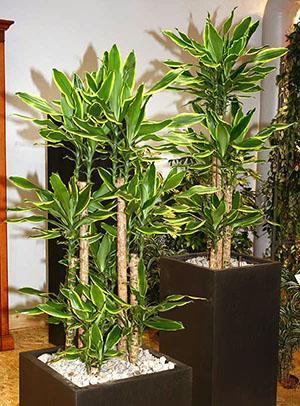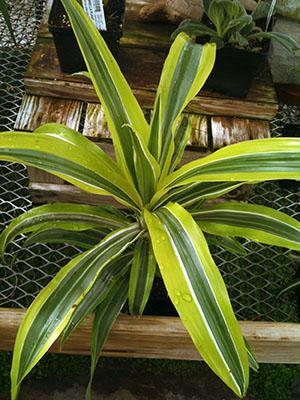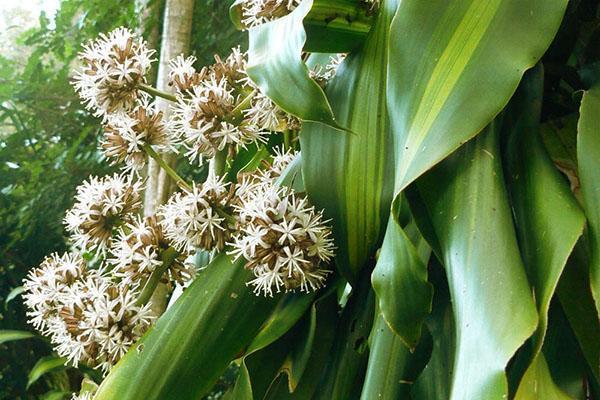Dracaena fragrant care and reproduction at home
 In the warm climate of Central and West Africa, many of the flora are large evergreen crops. Fragrant dracaena, found in a dozen African states, grows in nature to a height of 6 meters and strikes with juicy glossy foliage, densely covering the erect stem.
In the warm climate of Central and West Africa, many of the flora are large evergreen crops. Fragrant dracaena, found in a dozen African states, grows in nature to a height of 6 meters and strikes with juicy glossy foliage, densely covering the erect stem.
Dracaena fragrant: features of a houseplant
At home, this type of dracaena is no less impressive, only the size of the plant is much more modest. The crown of the tallest varieties does not exceed 1.5–2 meters in height. But the main decoration of the view is not size, but curved, glossy foliage of rich color. In the potting culture, the brightest varieties of fragrant dracaena with leaves of 60 centimeters long, combining dark and light green shades, creamy yellow and white, are extremely popular today.

In the conditions of an apartment, dracaena bloom extremely rarely. The fragrant variety is no exception. But even a green or variegated specimen fits perfectly into any interior and becomes the main decoration of the room.
The unusual beauty of the African guest is not the only advantage of the species. Due to the unpretentiousness of fragrant dracaena, caring for it will not take much time and effort.
Caring for fragrant dracaena at home: photo and description of work
All dracaena are ideal plants for indoor keeping. They are undemanding to the composition and nutritional value of the soil, easily tolerate placement in partial shade. You don't need any specific care and fragrant dracaena. It grows beautifully on western and eastern windows, on loggias and in the depths of the premises.
The varieties with green leaves are the most resistant to low light. If a dracaena with bright striped foliage appears in the house, then she needs to find a lighter place, otherwise the pattern on the leaf plates will fade or disappear altogether.
 Like other indoor cultures, fragrant dracaena, in the photo, does not like drafts:
Like other indoor cultures, fragrant dracaena, in the photo, does not like drafts:
- on summer days, the plant is comfortable at temperatures from 19 to 25 ° C;
- in winter, the room where the flower is located should be somewhat cooler, about 10-14 ° C.
To maintain the beauty of foliage and its juiciness, dracaena provide increased air humidity. This is especially important in the hot season, when the plant is not only actively developing, but also evaporates moisture. In the summer and during the rest of the year, it is useful to wipe the foliage with a damp cloth. Such care for fragrant dracaena will improve the appearance of dracaena and help the plant breathe.
 With the change of season, the need for water changes. First of all, this concerns the amount of irrigation water relying on the culture:
With the change of season, the need for water changes. First of all, this concerns the amount of irrigation water relying on the culture:
- In summer, the earthen lump under the plant should be slightly damp, and its drying out threatens to change the color of the foliage and its wilting.
- In winter, at low temperatures, excess moisture is even more dangerous. Excessively moist soil is the cause of root rot.An exception is the situation when the fragrant dracaena does not go to winter. In warm dry air, the crop must be watered and sprayed.
Usually watering is carried out twice a week in summer and no more than once every two weeks in winter.
Loosening the surface layer of the soil under the plant:
- has a beneficial effect on the condition of the root system;
- regulates the moisture content of the substrate;
- increases the penetration of oxygen deep into it.
 As part of year-round care for fragrant dracaena, at home, as in the photo, plants must be fed:
As part of year-round care for fragrant dracaena, at home, as in the photo, plants must be fed:
- in the warm season complex formulations for palms and dracaena they are brought in twice a month;
- in the winter months, the intervals between dressings are doubled.
The first transplant is waiting for a young fragrant dracaena 2-3 years after planting. Further, adult specimens are transferred to larger pots every 3-4 years. The substrate for dracaena of all types needs a loose, lightweight. It is optimal to take a specialized mixture for palm trees and add a little sphagnum, pieces of red brick and crushed charcoal to it. At the bottom of the pot, a powerful drainage layer is required to drain excess moisture.
Pruning and reproduction of fragrant dracaena
 The older and taller the picture on photo of dracaena fragrant, the more it resembles a palm tree. Old leaves dry up and leave the trunk, which remains bare and devoid of lateral shoots.
The older and taller the picture on photo of dracaena fragrant, the more it resembles a palm tree. Old leaves dry up and leave the trunk, which remains bare and devoid of lateral shoots.
An adult plant at home requires props, but this measure does not help when decorativeness is lost.
In this case, it is reasonable to resort to updating. In dracaena, cut off the top of the shoot with 5 - 7 leaves. Cover the bare trunk with a bag and leave it warm. After about a month, the awakened buds begin to form additional lateral shoots. As a result, the plant is shortened, becomes lush and more interesting.
 The remaining top of the dracaena should not be thrown away. This is an excellent apical stalk for rooting and propagation of fragrant dracaena.
The remaining top of the dracaena should not be thrown away. This is an excellent apical stalk for rooting and propagation of fragrant dracaena.
Lower part of the top:
- freed from several leaves at the base of the cutting;
- placed in water with the addition of crushed charcoal or buried a couple of centimeters in a mixture of sand, sphagnum and peat.
Under a film or in a greenhouse, the dracaena will give roots in 3-4 weeks. So you can become the owner of a new specimen of decorative culture. The easiest way to propagate fragrant dracaena is in the spring or in the second half of summer.